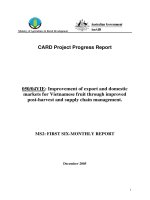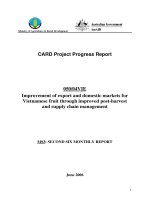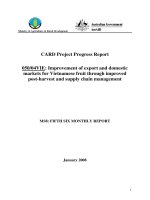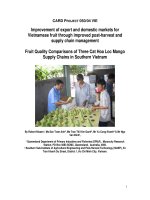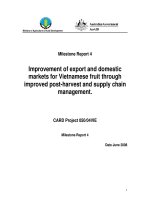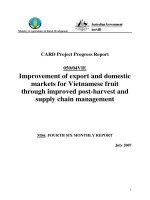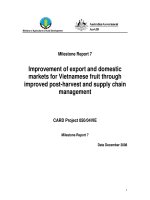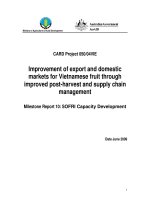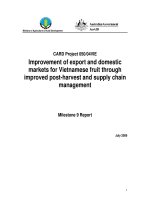Báo cáo nghiên cứu nông nghiệp " Improvement of export and domestic markets for Vietnamese fruit through improved post-harvest and supply chain management " pot
Bạn đang xem bản rút gọn của tài liệu. Xem và tải ngay bản đầy đủ của tài liệu tại đây (2.08 MB, 51 trang )
R.J. Nissen, Dr P. Hofman (DPI&F) , and M. Rankin (UQ)
Slide 1
Workshop 1
April 2006
No Chi Minh City Vietnam
Project:- “Improvement of export and domestic markets for Vietnamese
fruit through improved post-harvest and supply chain management.”
Australian Government AusAID CARD Project 050/04 VIE
“Improvement of export and domestic markets for Vietnamese fruit through improved
post-harvest and supply chain management.”
R.J. Nissen, Dr P. Hofman (DPI&F) , and M. Rankin (UQ)
Slide 2
CARD Project:- Improving Supply Chains
Welcome everyone
R.J. Nissen, Dr P. Hofman (DPI&F) , and M. Rankin (UQ)
Slide 3
CARD Project 050/04 VIE
This CARD Project 050/04 VIE
Improving Supply Chains
builds upon the previous
CARD Project that helped
establish and maintain several
farmer associations in
Southern Vietnam.
R.J. Nissen, Dr P. Hofman (DPI&F) , and M. Rankin (UQ)
Slide 4
CARD Project Aims
•Improve the potential of the horticultural industries
– export & domestic marketing
•Work with established supply chains (a pomelo and a mango
supply chain)
• Demonstrate the processes of strategic plan development
and implementation to the selected supply chains
• Assist in implementing the strategic plan
•Evaluate performance
R.J. Nissen, Dr P. Hofman (DPI&F) , and M. Rankin (UQ)
Slide 5
Activities so far
November 2005 Workshop 1
• Introduction to project
• Its benefits:
– identify problems
– empowerment
– increased fruit quality
•How
– targeted training/experience in strategic planning for specific
supply chains
– Involving project and industry partners
– Helping to implement the plan by providing training to
improve skills
R.J. Nissen, Dr P. Hofman (DPI&F) , and M. Rankin (UQ)
Slide 6
November 2005 Workshop 2
Supply/Value Chains
• What are they ?
• What are the benefits ?
• Relationships (working together)
• How to make supply/value chains work
?
R.J. Nissen, Dr P. Hofman (DPI&F) , and M. Rankin (UQ)
Slide 7
November 2005 Workshop 3
Interview techniques and questionnaire design
To obtain information about the nature and performance of the selected
supply chains
Structured and unstructured Interviews
• Tips to interviewing
•Bias
• Establishing credibility
• Questioning techniques
• Face to face
• Designing questionnaires
• Examples of questionnaires
R.J. Nissen, Dr P. Hofman (DPI&F) , and M. Rankin (UQ)
Slide 8
November 2005 Workshop 4
Monitoring Quality
• Sequential sampling along the supply chain
• What is quality ?
– External
– Hidden attributes
– Expectations
Mango
– Disorders
– Diseases
–Pests
R.J. Nissen, Dr P. Hofman (DPI&F) , and M. Rankin (UQ)
Slide 9
The April/May trip - objectives
• Improve understanding of supply chains and
strategic planning
• Provide training in processes to develop a
strategic plan for specific supply chains
• Use these processes on a mango and a pomelo
supply chain
• Provide experience in collecting accurate
information on the performance of the current
supply chain
• Discuss the application of these processes to
other horticulture supply chains
R.J. Nissen, Dr P. Hofman (DPI&F) , and M. Rankin (UQ)
Slide 10
The April/May trip - plans
Date
Date
Activity
Activity
Detail
Detail
Friday
21
st
April
Plan (Workshop 1) Discuss strategic planning, explain and improve the processes for the
main workshop, adjust trip plans
Mon-Tues
24
th
-25
th
Wed-Fri
26
th
-28
th
Mon 1
st
May
Tues-Wed
2
nd
-3
rd
Thurs 4
th
Main workshop with project partners and supply chain representatives.
Develop draft strategic plan for both supply chains
Develop draft
strategic plan
(Workshop 2)
More information
Evaluate
understanding
(Workshop 3)
More “training”
Refine the plan
(Workshop 4)
Visit the key partners in both supply chains.
Obtain missing information identified in the main workshop.
Demonstrate process analysis and quality assessment.
If possible, discuss experiences of the previous week.
–Understand the processes used in the main workshop
–Understand process analysis and quality assessment
Identify additional “training” in supply chain assessment and
improvement
Further discussion and “training” in strategic planning and supply
chain assessment.
Refine supply chain strategic plan based on the above
Project activities
(Workshop 5)
Develop action plan for project activities for the next 12 months
R.J. Nissen, Dr P. Hofman (DPI&F) , and M. Rankin (UQ)
Slide 11
Strategic planning – essential requirements
Accurate strategic planning requires good processes to:
• Obtain strong commitment from all supply chain members to
objectives (assumed).
• Collect accurate information from all important supply chain
members.
• Develop an action plan that most efficiently achieves objectives.
Thus:
• Process is very important
This trip:
• Describe and improve processes for developing strategic plans
(Poor processes – poor results).
• Recognise the current information may not be accurate or complete
at this stage, but this can be improved later.
R.J. Nissen, Dr P. Hofman (DPI&F) , and M. Rankin (UQ)
Slide 12
The workshop manual
Chapter
Chapter
Content
Content
1 Introduction
–Objectives
–Critical factors
–Itinerary
2 Strategic planning process-overview
–The general strategic planning process
–Overview of processes to be used in this project
3 Processes for the April-May workshops
–Information gathering
–Compile and summarise (mapping)
–Analyse (SWOT)
–Determine what is required (GAP)
–Action plan
–Evaluate (ORID)
R.J. Nissen, Dr P. Hofman (DPI&F) , and M. Rankin (UQ)
Slide 13
The workshop manual (cont.)
Chapter
Chapter
Content
Content
Summary of specific tools
4 SWOT analysis
–strengths, weaknesses, opportunities, threats
5 Gap analysis
6 Gathering more information-Process analysis
7 ORID analysis
8 Fine tuning
–test of supply chain fit
–the start to end focus
–simplicity test
–integrity test
Appendices •Suggested strategic plan structures
•Process analysis examples
R.J. Nissen, Dr P. Hofman (DPI&F) , and M. Rankin (UQ)
Slide 14
Strategic planning process for supply chains
Situation
Analysis
Supply Chain
Maps
Business
Assessment
Strategic
Issues
SWOT Analysis
GAP Analysis
Goals
Priorities
Strategies
and Act
Action plan
Monitor and Evaluate
Bennett’s Hierarchy
Vision
R.J. Nissen, Dr P. Hofman (DPI&F) , and M. Rankin (UQ)
Slide 15
Overall Project planning
Strategic overview (Project planning stage)
Identify industries
(Project planning stage)
Identify supply chains wanting to improve
(Project planning stage and confirmed in Trip 1)
Strategic plan
Implement strategic plan
Strategic planning part 2
R.J. Nissen, Dr P. Hofman (DPI&F) , and M. Rankin (UQ)
Slide 16
Specific supply chains (April-May)
Supply Chain wanting to Improve
Information gathering
(Up to April 2006, during April-May trip, and after)
Evaluate
(end of project and
beyond)
Compile & summarise
(flow maps etc)
Analyse
(SWOT, principles of
good supply chain)
Action Plan
(Who How When)
Implement
(Grower training etc)
Suggest a new
supply chain
What is required (GAP
analysis etc)
Strategic plan part 1
R.J. Nissen, Dr P. Hofman (DPI&F) , and M. Rankin (UQ)
Slide 17
1. Confirm future direction for the supply chain
2. Information on the existing supply chain
3. Compile and summarise this information
4. Analyse the information
5. What do we need to do to improve
6. Develop action plans
7. Implement and evaluate
(later)
What we will be doing
R.J. Nissen, Dr P. Hofman (DPI&F) , and M. Rankin (UQ)
Slide 18
Process
Process
Detail
Detail
1. Define and
clarify
Supply chain mission, aims, objectives.
Where does the supply chain want to be in 10 years time (increasing
exports etc)
2. Collect the
information
Existing reports
Original information from interviews, discussions, supply chain studies
(quality losses)
Discussions during the workshop with supply chain members
3. Compile and
summarise
Map the flows of product, information and funds
Identify:
–Activities and services
–Critical logistic issues
–Key decision makers
–External influences
Assess supply chain performance
–Customer satisfaction
–Relationships and communication
–Creating and sharing value
Process for the main workshop
R.J. Nissen, Dr P. Hofman (DPI&F) , and M. Rankin (UQ)
Slide 19
Process
Process
Detail
Detail
4. Analyse SWOT (strengths, weaknesses, opportunities, strengths)
Performance against six principles of successful supply chains
–knowing customers and consumers
–creating and sharing value
–getting the product right
–logistics and distribution
–information and communication
–effective relationships.
5a. Identify
the improved
supply chain
•What are the detailed practices of the improved supply chain
•How do these compare to existing supply chain practices
•How do these compare to suggestions raised during previous sessions
•Identify areas for improvement (Gap analysis)
Process for the main workshop (cont.)
R.J. Nissen, Dr P. Hofman (DPI&F) , and M. Rankin (UQ)
Slide 20
Process
Process
Detail
Detail
5b. Prioritise
possible
improvements
•List possible improvements under the six principles of successful supply chains.
•Combine similar ideas
•Number will be suggested improvements
•And ask participants to list the five most important improvements
•Place a tick against each improvement based on the voting
•Identify the improvements receiving the most votes
•Discuss the results
•Confirm the most important improvements
6. Develop
action plans
What needs to be done/provided to develop these improvements
–knowledge/skills
–infrastructure/facilities/resources
–Relationships
Develop action plans for:
–What is to be done, how, by whom, and when
7. Evaluate •Evaluate the performance of the new supply chain (repeat the process)
•Identify further improvements
(May not have time within this project)
Process for the main workshop (cont.)
R.J. Nissen, Dr P. Hofman (DPI&F) , and M. Rankin (UQ)
Slide 21
Essential requirements
1. Accurate information
– Will use several processes to look at the
supply chain
• Encourage critical evaluation
– Must have supply chain members present (we
do not know it all!)
– Must be encouraged to participate
– Will they be comfortable in a workshop? Will
they feel threatened?
– How can we improve the information we have
– More information collected during farm visits
etc
– This is an ongoing process
R.J. Nissen, Dr P. Hofman (DPI&F) , and M. Rankin (UQ)
Slide 22
Essential requirements (cont.)
2. Accurate determination of
priorities and action plans
– Have all major members of the
chain involved
– Don’t let one person/group
dominate
– Encourage involvement
Bias is
dangerous
R.J. Nissen, Dr P. Hofman (DPI&F) , and M. Rankin (UQ)
Slide 23
The April/May trip - plans
Date
Date
Activity
Activity
Detail
Detail
Friday
21
st
April
Plan (Workshop 1) Discuss strategic planning, explain and improve the processes for the
main workshop, adjust trip plans
Mon-Tues
24
th
-25
th
Wed-Fri
26
th
-28
th
Mon 1
st
May
Tues-Wed
2
nd
-3
rd
Thurs 4
th
Main workshop with project partners and supply chain representatives.
Develop draft strategic plan for both supply chains
Develop draft
strategic plan
(Workshop 2)
More information
Evaluate
understanding
(Workshop 3)
More “training”
Refine the plan
(Workshop 4)
Visit the key partners in both supply chains.
Obtain missing information identified in the main workshop.
Demonstrate process analysis and quality assessment.
If possible, discuss experiences of the previous week.
–Understand the processes used in the main workshop
–Understand process analysis and quality assessment
Identify additional “training” in supply chain assessment and
improvement
Further discussion and “training” in strategic planning and supply
chain assessment.
Refine supply chain strategic plan based on the above
Project activities
(Workshop 5)
Develop action plan for project activities for the next 12 months
R.J. Nissen, Dr P. Hofman (DPI&F) , and M. Rankin (UQ)
Slide 24
Field trips – gathering more information
Objective
Objective
• Get more accurate information
• Increase member confidence and commitment
Process
Process
• Visit key parts of both supply chains
• Present the key results of the workshop
• Ask if the results seem accurate
• Discuss what further information is required
• Use process analysis
• Not essential to see everything
– be selective
– demonstrate the processes; more information gathering later
R.J. Nissen, Dr P. Hofman (DPI&F) , and M. Rankin (UQ)
Slide 25
Evaluate processes and understanding
Monday 1
st
May?
Main project leaders from SOFRI and SIEAP
Discuss:
• Workshop
– Did it get the right information
– Was there open interaction
– Was it a good process
– What about the facilitators and aids
• Field days
– Did the supply chain members understand what we are trying to do
– Do they see benefit in the approach
– Will they be committed to this approach
– Did process analysis work (enough and accurate information)
•Plan
• What additional training/discussion in the concepts and processes
• Structure for Tuesday/Wednesday

